Why Does Agency Project Management Matter?
Let's first level set - why does agency project management warrant this level of attention for agency leaders? There are several key reasons.
1) It Directly Impacts Client Satisfaction
At the end of the day, your clients care about outcomes, not your internal processes. But stellar project management leads to happier clients and better work.
Missed milestones, scope creep, and poor communication due to weak agency project management cause clients to become frustrated and skeptical.
Related: Commence Studio Increases Client Satisfaction with Streamlined Operations
2) It's Vital for Profitability and Efficiency
Profitability stems from both efficiency of delivery and value pricing. Efficient delivery depends on excellent project management - clear requirements, realistic scoping, accountability to schedules.
While value pricing depends on packaging services, estimating timelines accurately, tracking profitability per project, and more.
Related: 9 Strategies to Make Your Agency More Profitable
3) It Facilitates Scaling Your Team
As your team grows to 20, 50 or 100+ members, you cannot micromanage their work.
Effective project management provides autonomy through clarity of expectations, transparency into workloads, and accountability to outcomes. This enables teams to scale successfully.
Related: How Pilothouse Scaled to 170+ Employees in Under 3 Years
4) It Supports Strategic Decision Making
With mature project management processes, you gain access to powerful data on where time is actually spent, which services are most profitable, forecasts for capacity planning, and more.
This data fuels important strategic decisions on growth.
Related: Venn Digital Marketing Sees Profitability Soar After Making a Pivotal Business Decision
Now that we've established the immense value of project management for agencies, let's explore the top lessons from how elite agencies approach it.
Lesson 1: Use Tools That Combine Simplicity and Powerful Insights
The most successful agencies leverage project management software that offers both simplicity for team members and powerful analytics for leadership.
And despite us being the first and largest ClickUp solutions partner, I wont sit here and say that ClickUp is the best project management tool for every agency.
Some of the most successful agencies are running on Monday.com, Teamwork.com, and Asana.
But the most successful agencies have figured out a way to make the user experience stupid simple, while also making the reporting extremely powerful.
For team members, the tool's interface should make it extremely easy and intuitive to:
- Get assigned tasks with due dates, priorities, and time estimates
- Update progress on work
- Log time spent on projects
- Communicate with teammates and clients
This simplicity ensures high adoption across all team members and smooth day-to-day operations.
But while the team experience is simple, the tool should also provide sophisticated reporting, analytics, and insights for leadership. At a high level this includes:
- Dashboards with key metrics on utilization rate, margin per project, capacity vs workloads, etc.
- Reporting on profitability per client, service offering, etc.
- Forecasts for future resourcing needs and gaps
- Tools to analyze gaps in adoption, consistency or performance
This enables agency leaders to make smarter strategic decisions on pricing, resourcing, investments, and more.
Related: How to Choose the Best Project Management Tool For Your Agency
Lesson 2: Build Clear Scorecards and Project Management Tooling to Produce Key Measurables
The highest performing agencies design their project management processes and tools to feed directly into key metrics and KPIs that matter most.
Instead of implementing their project management system first, they focus their efforts on identifying their most important metrics and goals, building their scorecards, and then designing their PM system to give them that data.
These metrics may include:
- Utilization Rates - percentage of total hours spent on billable work.
- Gross Margin - profit margins for client work.
- Client retention rate - percentage of clients retained quarter to quarter.
The list goes on, but the point is identifying the 5-10 metrics most vital to your agency.
Leadership needs to define these first, and then share them with team leads and managers. All of this should then trickle down throughout the organization to define individual scorecards metrics to track against larger goals.
After the end goal is in mind, you'll implement project management tools and processes to consistently capture the data required to calculate those KPIs.
For example, to measure profitability per client or project, tasks and time tracking would need to tie back to both specific projects and clients.
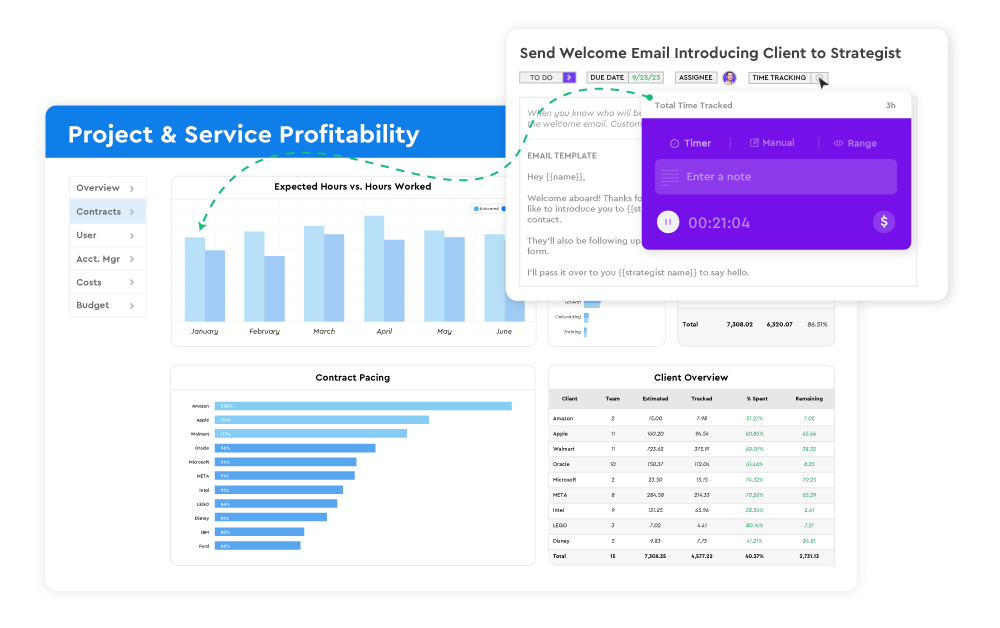
This sounds like an easy solution, but it relies heavily on your project management system hierarchy and where you track your time.
If your hierarchy and time tracking solution are disconnected and not built in a way that relates time to specific clients, projects, and deliverables, you'll struggle to get the data you need to measure against your scorecard metrics.
That lack of visibility into key metrics makes it impossible to manage your agency's health and growth effectively.
Agencies who begin with the end in mind see much more success.
This is why our Agency Operator Blueprint process begins with an "Agency Operator Scorecard" that defines your scorecard metrics and goals to understand the impact that better operations can have on your business.
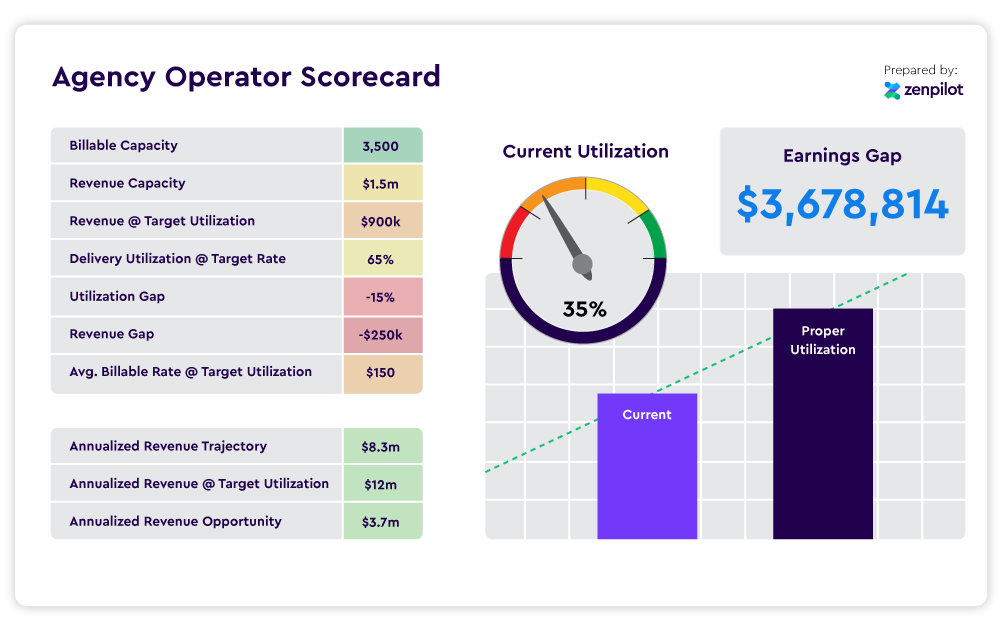
The Only Fully Guaranteed Agency Operations Improvement Framework
Get 360 clarity into your operations or your money back, guaranteed.
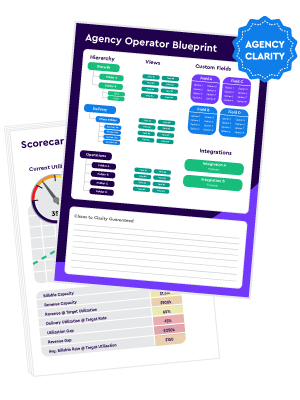
Lesson 3: Make The Process Live Where The Work Gets Done
All successful agencies have well documented processes and playbooks for their most common workflows - client onboarding, recurring deliverables, new project kickoffs, and more.
But there is a massive difference between documentation that sits in a Google Drive, and actionable processes woven directly into tools where work takes place.
When processes and tasks live in different places that are disconnected, you're creating friction.
And friction kills compliance.
If you separate the process from where the work is happening, it is extremely difficult to get compliance.
Your team should never have to hunt for a process on how to onboard a new client or build a new landing page.
If they do, they'l be less productive, and probably won't follow your standards.
But what does process living where the work get's done look like?
Let's look at a common agency process for an example - client onboarding.
Client Onboarding - Process Example
First, your workflow needs to be built directly in your project management system.
This should be built with parent tasks, subtasks, due dates, assignees, custom fields, and dependencies.
Each task should be built with a specific step that needs to be completed by a person.
For example, our client onboarding workflow would look something like this:
- Client Onboarding (deliverable)
- Send welcome email introducing client to strategist - assigned to AE
- Reply to welcome email and send intake form - assigned to strategist
- Create internal slack channel and add team members - assigned to admin
- Add client contacts to Retently (NPS software) - assigned to admin
- Run Kickoff Call - assigned to strategist
Secondly, within each of these tasks inside your project management system, they need to have checklists and task descriptions to provide details on how this task should be performed.
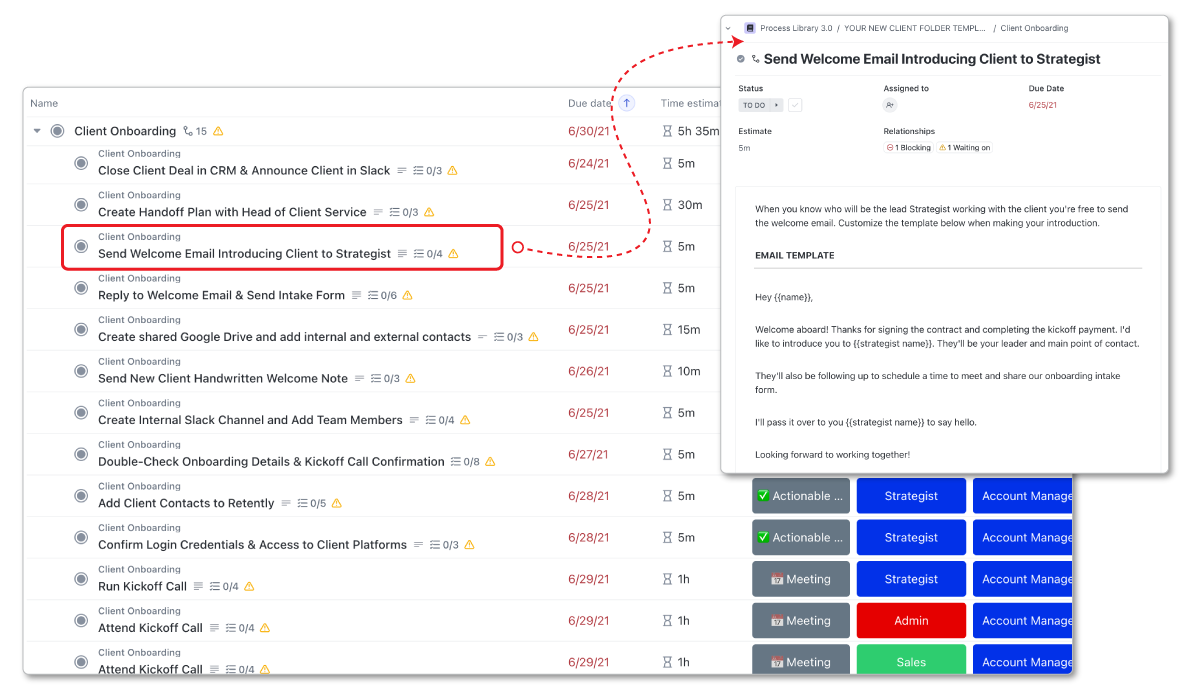
Task descriptions will serve as detailed instructions to a beginner on how to perform a task.
These descriptions can include:
- A recorded video that walks someone through the step-by-step instructions of how to complete the task.
- Email templates that someone can copy and paste to save them time and keep communication consistent.
- Links to SOP documents.
- Links to other templates.
- Written instructions on how to complete the task.
All of this work may not pay-off right away for super small teams, but for those that want to scale, being super explicit in your processes and keeping them where the work get's done is extremely important to keep your team productive and your clients happy.
Client Onboarding ClickUp Template
Access our pre-built Client Onboarding ClickUp template, 100% free.
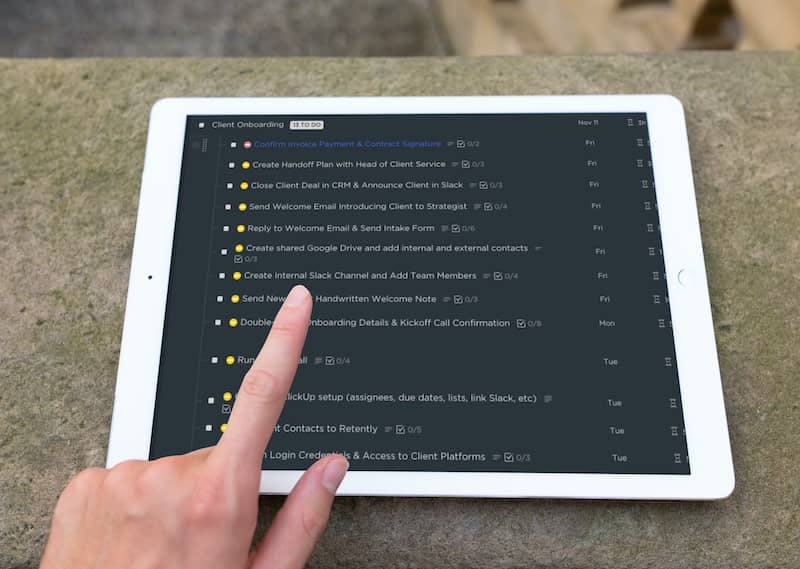
Lesson 4: Lead with Explicit Expectations, Scale with Details (Clarity = Kindness)
If you worked with our team at ZenPilot, you'd hear the phrase, "clarity is kindness" about 50x per/week.
This is extremely important.
To be successful, we need to know what success looks like first.
Scott Skully, CEO of Abstrakt Marketing Group is a huge influencer on this topic.
At Abstrakt, every role on their team has a detailed break down of how they should spend their time.
For example, a content marketing manager role may entail:
- Being a great teammate (20%). This revolves around communication - meetings, email, Slack, ClickUp, 15Five, reporting (scorecards), managerial + recruiting duties, etc.
- Meetings ➝ 3 hrs between L10 Meeting™, 1:1's, and as-needed
- Email/Slack/ClickUp ➝ make this take <3hrs/week
- 15Five (submission + review) ➝ 30m/week. This could be part of analyzing/learning/strategizing/planning, but let's treat this differently.
- Reporting ➝ 30m/week (5m/day + 5m for Growth Scorecard prep on Monday)
- Other ➝ 1h/week...this will vary. Many weeks can be 0, but if you're recruiting/interview/etc, this may take more time.
- Analyzing, learning, strategizing, and planning (10%)
- (1 hr/week) The first component here is Monthly Strategy & Planning. This will not be a half day every single week. Instead, you should have a half day every month to review progress, build any reporting, plan the next initiatives, and bring them to life correctly in ClickUp.
- (1 hr/week) Additionally, you should have a short, but consistent weekly analysis block. This is where you program into your head and internalize where we stand on key metrics, pay attention to what's working and what's not, dig deeper into specific areas based on the week, and analyze our output and address any velocity of shipping or quality of work issues across the marketing team
- (1 hr/week) And with a chance to digest your analysis (i.e. I would not personally put these directly back-to-back), you need a short, but consistent weekly strategy + planning block.
- Executing as a producer (35%). This ratio will shift over time (a 6-person team is very different from a 2-3 person team), but for now, this is where you want to invest one of the largest chunks of time. This includes things like:
- Interviewing team members and publishing videos/writing articles/email/content based on their expertise + your own POV/expertise
- On-site SEO execution
- Writing + implementing emails + website content
- Efficiently working through content revisions
- Podcasts/webinars/live streams/YT videos
- Ad creation
- Interviewing team members and publishing videos/writing articles/email/content based on their expertise + your own POV/expertise
- Executing as a promoter (35%). The other side of the coin and where, IMHO, we have the most opportunity.
- We have more high-quality ClickUp + agency PM related content than just about anyone else in the world. Yes, we should have a muscle of producing more, BUT...we need to be showing + telling that content more. This is things like:
-
Social (LI-first approach is probably fine, but how can we be testing other platforms?)
- Use the Content Branching System to create content that each member of our team can cycle through sharing
- Do the same thing with any shorts or quotable moments from our podcast guests + webinars/videos/live streams.
-
- We have more high-quality ClickUp + agency PM related content than just about anyone else in the world. Yes, we should have a muscle of producing more, BUT...we need to be showing + telling that content more. This is things like:
These percentages can vary based on agency services and structure.
The point is to explicitly communicating time allocation expectations, rather than assuming everyone shares the exact same vision of roles.
Bring this detailed role description to a 1-on-1 meeting with the person filling that role and ask for their feedback.
Have some dialogue on it and then build their ideal week in Google Calendar. This will help determine time blocks for them to perform specific role requirements.
- Should this task be done first-thing in the morning?
- Can it be done later in the day?
- Should we batch it and have your whole Tuesday spent on this?
This can done differently for every person depending on how they are wired. You'll most likely have two kinds of people in your organization:
- Bricks - These people have and need a super-defined role. They don't need much margin time built in to their role.
- Glue - These are the people that hold everything together and they're floating across different roles and responsibilities. They need more margin time built in to their roles.
Regardless, leaders should over-communicate these expectations through documentation, 1-on-1s, mentorship, and coaching. The ideal state is where team members know exactly what they should be focused on, removing all ambiguity.
This clarity and alignment enables team members to operate autonomously in a remote or hybrid environment. And it ensures smooth coaching conversations when gaps arise between expectations and actual results.
Related: How to Build a Resilient and Empowered Company Culture
Lesson 5: Define Your Methodology of Project Management; Understand & Solve for Gaps
While agency project management is crucial, there are many flavors and nuances of project management methodology.
Every agency needs to clearly define and document their approach.
90% of ZenPilot clients use a "Due Date Driven" methodology.
All this means is that every task in our project management system has a due date, assignee, and a time estimate (time estimates are used to help us see workload) .
The due date is our primary prioritization matrix. Aside from this, you can also use a prioritization field, but the due date is the most important.
This methodology populates a "My Tasks" view for everyone. Everyone at the agency has one place they need to go to, to see and complete their work.
Besides the "Due Date Driven" framework, the other 10% of ZenPilot clients, operate an an agile framework, which will look slightly different.
BONUS
Download the Complete ClickUp for Agencies Guide FREE
The 47-page guide includes graphics, checklists, and links to how-to videos so you can actionize your ClickUp plan.
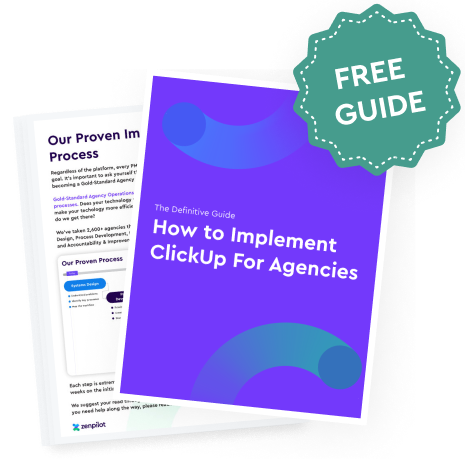
Every Project Management Methodology Has a Gap
However, regardless of which methodology is chosen, there will always be weaknesses and gaps.
Our "Due Date Driven" methodology relies heavily on tasks having assignees and due dates. This is what populate the "My Tasks" view mentioned earlier.
If someone accidentally removes a due date or assignee, this task will disappear from the "My Tasks" view and may slip through the cracks.
However, high-performing agencies understand it's not a "set it and forget it" approach.
They proactively analyze where projects commonly fall between the cracks, and build workflows to address those scenarios.
Within the "Due Date Methodology", you'll need views that capture all tasks without an assignee, or without a due date, or without a time estimate.
.png?width=1200&height=700&name=ClickUp%20Dashboard%20Example%20-%20ClickUp%20Champion%20(Task%20Issues).png)
Fixing these issues may involve new reports, assigned accountability, additional tooling, or process tweaks.
The key is continuously inspecting and evolving. Even long-tenured team members can become complacent over time.
Lesson 6: Cultivate a Culture of Accountability and Coaching
Everyone wants to have a culture of accountability. And this isn't just agency owners or operators - individual contributors want this too.
Ultimately any methodology, process, or tool is only as good as the level of accountability and adoption across your team. A culture of accountability is crucial.
Building this kind of culture takes time and effort.
This is how high-performing agencies do it:
1. Set Clear Expectations
This starts with explicit expectations as discussed earlier - roles, time allocation, metrics etc.
You cannot hold people accountable without first being crystal clear on what you expect.
At ZenPilot, we provide all of our clients with an "Agency Project Management Certification".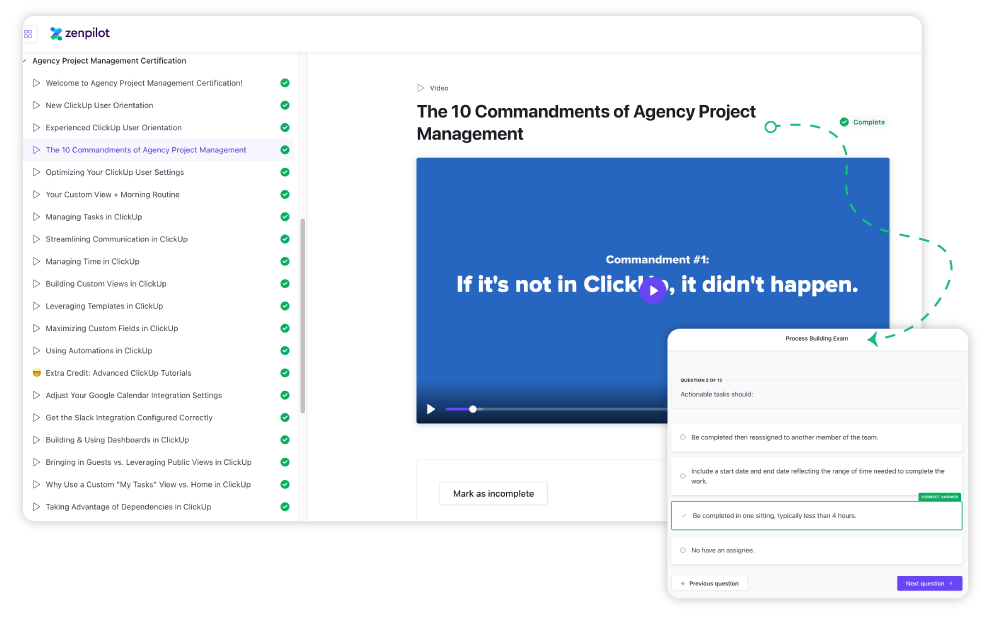
This certification course provides the team with clarity on the software (ClickUp in this case), and the expectations of them.
But this doesn't hold anyone accountable, it just sets the expectations of them which we now have to hold them accountable to.
2. Create a Single Source of Truth
If you want to hold your team accountable, you need a way to capture what they've done and are doing.
Without a single system to provide you with a paper trail of everything that's happened, you won't be able to hold your team accountable.
One of our project management commandments at ZenPilot is, "If it's not in ClickUp, it doesn't exist".
Therefore, if you don't put a task in ClickUp, we will assume it didn't happen. Thus enabling management and leadership to have a birds-eye view of everything that's happening, and providing them with the data they need to know if the team is or isn't meeting expectations.
3. Commit to Routine Inspecting and Reviewing
After setting expectations and creating your single source of truth, you can now hold your team accountable.
We'd recommend that you work through 4 different practices/habits to hold the team accountable.
Assign a project manager or operations leader - we call them a ClickUp Champion - to consistently perform these reviews (listed below).
1) The Daily Spot Check
A 10-30 minute (depending on firm size) audit at the end of each work day. This spots bad habits and makes sure that nothing is slipping through the cracks.
You'll be answering questions like:
- What's overdue?
- What's not updated in the system that should've been updated?
- Where did an assignee, due date, etc. get accidentally pushed off of something?
You can build simple dashboards in your project management system to perform this task.
2) The Weekly Roundup
A slightly deeper dive on a weekly basis that leads to a short aggregated report to management.
Additionally this report will be sent to anyone that's showing recurring issues.
- Is there someone that is not tracking time when that was the expectation?
- Is there someone that's not adjusting due dates or leaving comments when a task falls overdue?
3) The Monthly Review
A monthly review that pulls data for management that should impact resource allocation, project scoping, pricing, etc.
This starts to answer questions like:
- How are we doing on a utilization or margin perspective?
- What projects are going off the rails?
- Where are we actually making money?
- Who is overloaded or not and where can we make adjustments?
4) The Quarterly Analysis
Lastly, you'll want to use your quarterly analysis to go the next level deeper.
Your monthly reviews may show a service line profitability issue.
If SEO is our least profitable service line, we need to figure out why.
Is it a delivery issue, a packaging issue, or a pricing issue? And if it's none of those, or maybe beyond repair, maybe it's time to completely kill it or outsource it.
These decisions need to be made as agencies continue to scale.
4. Reward positive results
And lastly, reward your team for positive results.
Too often accountability focuses only on the negative. But reinforcing and celebrating positive outcomes is equally important. Publicly highlight contributors who go above and beyond.
Showcase great work delivered for clients and find opportunities to positively reinforce results.
All of these together will help your team build a culture of accountability.
Lesson 7: Habitually Practice Decision-Making Based on Accurate Data
As agencies scale, their approach to key decisions should evolve from "gut feel" to deliberate, data-driven analysis.
Relying on intuition and emotions can be sufficient when an agency is small. But as more people, projects, and complexity get added, objectivity becomes critical.
When do these data-driven insights become most important?
From what we've noticed, most agencies die out when they hit the 20-30 person range.
Some agencies stall out at 5-10 people when they get beyond what 1 person can manage.
But most agencies die when they hit 20-30 people.
Why is this?
First, at this stage in the agency journey, agency founders and owners need to get the next layer of management in place. You're beyond just a few managers. You need to now know how to manage those managers to continue to grow.
Secondly, as a founder or owner, you're much more out of the day-to-day picture. Without leadership visibility and reporting set up, you'll struggle to manage your firm as you continue to grow.
If you're at the 20-30 person level, do you have these insights?
- Profitability by service offering
- Capacity forecasts vs utilization rates
- Client satisfaction and retention rates
- Adoption rates of processes and tools
These will help you spot issues to make smarter decisions on:
- Resource planning - What role(s) do we need to hire for? Should we bring on a contractor? Are there any tools that could help?
- Service offerings - Do we need to adjust pricing on this service? Can we change the way we are delivering it? Should we cut this service completely?
- Client selection - What kind of client(s) should we take more of? Has our ICP shifted at all?
- Pricing and packaging - How should we price and package our services?
All of this depends on widespread consistency and adoption of your project management processes.
Spotty or incomplete data leads to misinformed decisions. But accurate, holistic data provides tremendous strategic advantage.
A HubSpot partner, Venn Digital Marketing, streamlined their operations and created a culture of accountability to unlock these insights. After a few months of evaluating the data, they realized their main niche was actually their least profitable client.
They decided to make a shift in the clients they took on and saw a massive boost in profitability.
The earlier you can unlock these insights, the better you'll be in the long run.
The best agencies invest heavily in accountability, consistency, accurate tracking, and reporting to leverage this decision making super power.
Cancel chaos.
Create clarity.
You can build a happier, more productive, more profitable team with ClickUp. We'll show you how.
The Path Forward: Mastering Agency Project Management
In this comprehensive guide, we took a deep dive into how elite agencies approach project management and scaling their operations.
- Use Tools That Combine Simplicity and Powerful Insights – Invest in project management software that offers intuitive interfaces for team members while providing powerful analytics and reporting for leadership.
- Build Clear Scorecards and Project Management Tooling to Produce Key Measurables– Identify the key metrics that matter most and design your project management system and processes to capture that data.
- Make The Process Live Where The Work Gets Done – Embed procedures, checklists, and templates directly into the tools where work happens instead of isolated documentation.
- Lead with Explicit Expectations, Scale with Details (Clarity = Kindness) – Communicate responsibilities, time allocation expectations, metrics, and what success looks like for each role.
- Define Your Methodology of Project Management; Understand & Solve for Gaps – Decide and document your agency PM approach, while proactively identifying gaps and constantly improving.
- Cultivate a Culture of Accountability and Coaching – Commit to routines like daily spot checks, weekly reviews, monthly evaluations, and quarterly analyses to hold the team accountable.
- Habitually Practice Decision-Making Based on Accurate Data – Provide accurate data to fuel smart decisions on resourcing, service offerings, client selection, pricing/packaging, and more.
While project management is rarely glamorous, mastering these fundamentals can transform any agency's ability to profitably deliver great work at scale.
Taking your operations seriously will change your life.
At ZenPilot, we've lead 2,700+ agencies through the last project management implementation they'll ever need.
- We've helped agency owners increase productivity by 400%, completely remove themselves from operations, and sell their business.
- We've helped agencies grow profits by $1.2 million in year 1, triple headcount seamlessly, and improve client retention.
- We've helped lead complete culture resets, increased employee satisfaction, and slashed team turnover.
If chaotic project management is hindering your agency's growth, book a call with on of our experts.






